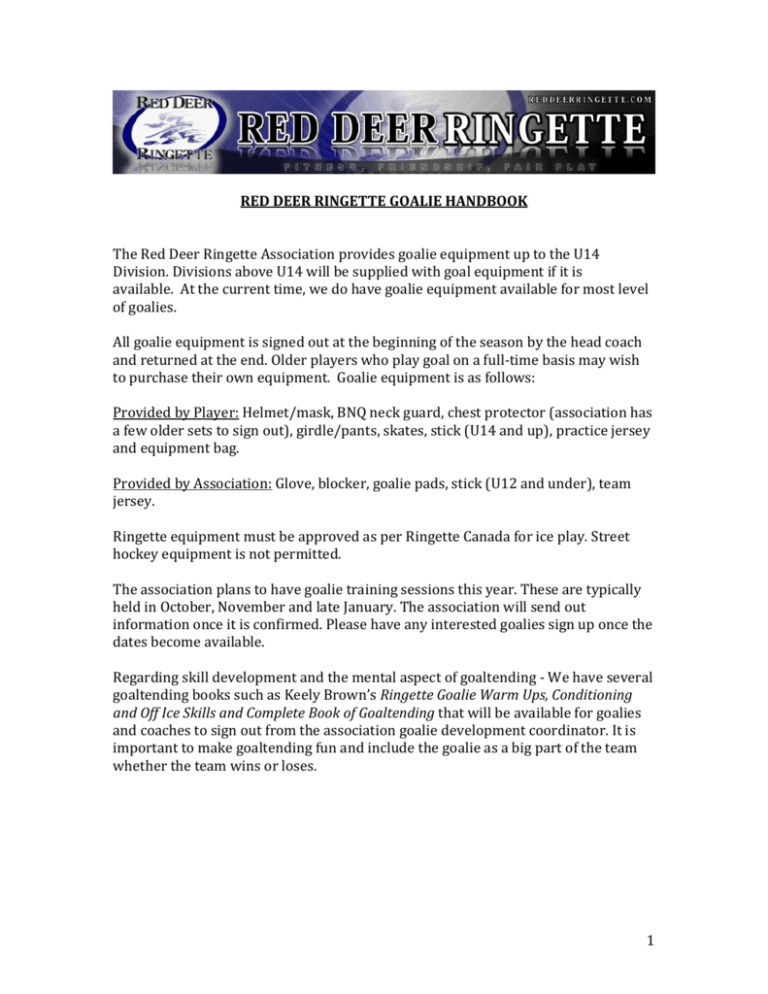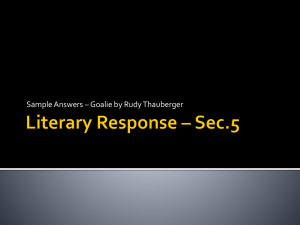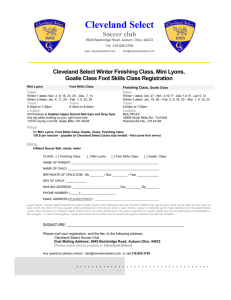RDR Coach Parent Goaltender Information
advertisement

RED DEER RINGETTE GOALIE HANDBOOK The Red Deer Ringette Association provides goalie equipment up to the U14 Division. Divisions above U14 will be supplied with goal equipment if it is available. At the current time, we do have goalie equipment available for most level of goalies. All goalie equipment is signed out at the beginning of the season by the head coach and returned at the end. Older players who play goal on a full-time basis may wish to purchase their own equipment. Goalie equipment is as follows: Provided by Player: Helmet/mask, BNQ neck guard, chest protector (association has a few older sets to sign out), girdle/pants, skates, stick (U14 and up), practice jersey and equipment bag. Provided by Association: Glove, blocker, goalie pads, stick (U12 and under), team jersey. Ringette equipment must be approved as per Ringette Canada for ice play. Street hockey equipment is not permitted. The association plans to have goalie training sessions this year. These are typically held in October, November and late January. The association will send out information once it is confirmed. Please have any interested goalies sign up once the dates become available. Regarding skill development and the mental aspect of goaltending - We have several goaltending books such as Keely Brown’s Ringette Goalie Warm Ups, Conditioning and Off Ice Skills and Complete Book of Goaltending that will be available for goalies and coaches to sign out from the association goalie development coordinator. It is important to make goaltending fun and include the goalie as a big part of the team whether the team wins or loses. 1 EQUIPMENT HOW TO: GOALIE PADS & STICKS How to put on goalie pads with no toe laces and regular skates (U10) This is recommended for goalies who are playing half a game and coaches need to switch pads at halftime. 1. Place the goalie pads on the ground so the inside knee risers (landing pads) are on the inside facing each other (padding to inside/buckles outsideprotects the knee and leg from hitting the ice if goalie goes down in a butterfly save). If you plan to switch goalies at halftime, they can wear their normal kneepads underneath the goalie pads to speed up the process. 2. With skates on, goalie can lie down in the pads, (knee should fit in knee cradle). 3. If there is a strap on the very bottom of the pad, it goes through the skate blade as best you can. Might be able to go behind the blade heel and buckle depending on the length of the strap. Do not let this strap fall on the ice as it can get under the skate blade. 4. Moving up, the next bottom strap/buckle across skate should be snug, either inside or outside skate, whichever goalie prefers. 5. Moving up, the next strap across calf can be snug as well. 2 6. All of the remaining straps above the knee should be very loose. No adjustments are usually necessary as long as they are as loose as they can go. 7. If these upper straps are too tight, the goalie will not be able to get up off the ice. You can have your goalie kneel down in the pads and view the straps from behind to ensure they are still loose 8. Double check to see that all straps loop back into buckle or that they cannot get under skate blades. Note: Toe bridge screws will come loose – parents and coaches need to check and periodically tighten. How to put on Goalie Pads using toe laces and goalie or regular skates Using toe laces is the best way if a goalie is to play a full game. There are many tutorials on the web for coaches & goalies. Here is a quick guide: 1. Lay pads face down on ground, with the inside knee risers/landing pads to inside and buckles to the outside. With properly sized pads, the knee should fit in the knee cradle. Toe lace towards goalie. 2. The toe lace must have a knot in it ¾” from the toe bridge. This is very important and creates a space to reduce injury to the hips, knees and feet. 3. With the goalie either standing or sitting, put skates up tight to the knot near the toe bridge on the pads, (tight to knot so lace cannot drop under front of blade on ice – very important). 4. Take toe lace and crisscross though first hole in skate blade, then crisscross through the middle blade hole and up over on top of the skate laces (may have to loop 2x depending on lace length), pull tight and tie on top of skate laces near the front of the skate; can double loop tie if the lace is long. For regular skates, crisscross through the blade hole, pull tight, and tie on top of the laces. 5. Double check toe lace is tight to skate and cannot fall below skate blade. 6. Goalie can now lie down in the pads. For sizing, check to see goalie knees fit into the pads knee pockets. 7. The bottom leather strap goes underneath through back or middle hole in skate blade. Back off one hole from ‘tight’, there is no need to over tighten this strap. Loop strap back into buckle so does not flop on ice and get under skate blade. 3 8. Working up from the bottom: Generally the straps are tighter at the bottom and get looser as you work you way up. The next bottom leather strap across skate can be snug but not too tight. Some goalies prefer this strap a bit loose. You should be able to get one finger in behind the strap when tightened to allow the pad to rotate for butterfly saves. You can tuck the end of the strap back into the buckle if needed. 9. Moving up, the next strap across calf can also be tightened to allow a finger or two behind it. 10. Depending on the goalie pad, there may be a Velcro strap over the calf or knee, snug all Velcro to hold pad in place. 11. All of the remaining straps from the knee up should be very loose. No adjustments are usually necessary as long as they are as loose as they can go. 12. Remember if the upper straps are too tight, the goalie will not be able to get up off the ice. You can have your goalie kneel down in the pads and view the 4 straps from behind to ensure they are still loose. Double check to see that all straps loop back into buckle or that they cannot get under skate blades. Note: Toe bridge screws will come loose – parents and coaches need to check and periodically tighten. STICKS The association provides goalie sticks for U12 and under. Contact the equipment coordinator if your team needs a stick. Goalie sticks come in many lengths and generally 3 lies (lie 13/13.5 – more for a crouching butterfly goalie, 14 – average, 15 for upright goalies). Properly sized goalie sticks should allow the goalie to hold the stick flat on the ice when the stick hand is at knee height and the stick being approximately 8-12” out from the goalie’s feet. It is recommended to hold the stick with the forefinger on front of the paddle (fat part of the stick), the thumb goes behind, and the remaining fingers on the handle. WARM-UP, STRETCHING & DRILLS Check your Ringette Drill Manual for warm-up and stretching exercises. Always have your goalie warm-up and stretch to prevent injuries. Stage #1 – Easy movements such as easy skating to increase blood flow. Goalies should do the skating warm-up with the team. Stage#2 – Stretching. It is easy to remember “stretch from top to bottom”. Start with head/neck and work down to legs. The main muscle groups that should be stretched are the large groups of their legs and trunk. Groin muscles and legs are especially important, as well as shoulders, back and abdominals. Stage #3 – Sport Specific Movements – Goalie can do side-to-side shuffles, down-ups, and work on forwards & backwards telescoping movements – see ‘letters’ below. Any of these are good to work on in practices as well as before games. Instead of crossovers, goalies can do circles using C-cuts. Ringette goaltending is a little different than hockey goaltending in that a Ringette goalie should try to remain upright more often than playing from their knees or having their “stick paddle down”. 5 Games Goalies should do the skating warm-up with the team. Ensure that goalies have a minute to stretch and get warm in their crease before warming up with shots. Your first set of shots should be straight shots from around the hash marks, make sure your skaters know that they shouldn’t be deking their goalie in the warm-up. If you have 2 goalies that are splitting the game, try to have the goalie starting the second half also gets some shots before going in. 6 7 Practices: There are many drills in Section 5 of the Ringette Canada Drill Manual. Goalies should do the skating warm-up with the team. Have your goalies do the first few skating drills, and then if you get into skating techniques such as tight turns, you can let the goalie go stretch in the crease and work on their goalie drills. When your team is skating circles, you can have the goalies do 1-foot c-cuts around the curves rather than crossovers. When your team is skating backwards, have the goalie skate backwards in a proper goalie position stance with stick on ice. RDR would like one coach from every practice dedicated to goalie development for that practice. a. They do not have to have goalie experience, just reference lesson plans/drills in the drill manual. b. Goal is to have someone with younger goalies at all times to help them ‘not stand around’, foster interest, and make it fun. c. Older goalies should have a coach they can build trust with, help with mental preparation as well. Should be a good communicator & supportive. d. Will also ask older goalies to attend practices as time permits to help younger goalies develop. We will try to make goalie practice fun at all levels but especially at the lower levels. Older goalies should come with pads on as younger goalies really enjoy this. Here are some basics to work on in practices: Stance: Goalies keep knees bent (not bending their back with knees straight), blocker and glove in front of body, stick flat on ice 8-12” in front of skates. o Remind goalie to always keep stick flat on the ice! Keep glove hand up and out when shuffling, t pushing, and c cutting. When goalies go down on pads, remind them to recover (stand up) with outside leg first. This allows them to push off outside leg back into the middle of their crease for rebounds. Work on angles, staying square to ring. Go over hugging the post for when the ring is behind/beside net - skate is against the post, heel of stick on toe of pad, arm around the outside of post, stick angled to block pass from behind net. o Try to have goalies watch the ring until their hip hits the other post, then hug other post properly and turn head. Movement side to side should be on the goal line, do not let them wander out to far or they 8 may skate too far past the other post. Practice until lead leg does not go by other post. Keep knees bent while moving, no bobbing up and down. o Square up to the ring when it moves out front; do not stay hugging the post. Ring Practice o Coach new goalies that they have 5 seconds (from when the ring enters the crease, not from when the goalie picks the ring up) to throw the ring. o Let the goalie know where you want her to throw the ring. Teaching a breakout such as throwing to a teammate behind the goal line, far side boards or in the corner is recommended. Coach skaters on positioning when goalie has the ring so goalie has someone to throw to. o Cannot throw it over the blue line to a teammate. Goalie can pass the ring with stick outside the crease and over the blue-line if goalie is strong enough. o Practice throwing the ring so it lands flat. Butterfly practice: Place 3 rings just outside the edge of the crease, one in the middle, and one on each side. Have the goalie start in the middle of the crease and c-cut out to the first ring, until their stick is almost touching the ring. They should butterfly here without moving the ring, which means that their stick will have to stay in the same place. Have the goalie back up to the net and then t-push over to the other rings and do the same thing. Legs wider may help goalie be able to butterfly. One tip for Defense: Coach your defensive triangle that you do not want to be set up right at the crease. Being this close allows the shooter in very close and also screens your goalie. Try to push out the triangle away from the crease a few “steps” which will help your goalie see the shot. Push shooters to the outside. Affiliate goalies should be welcomed at a few practices of the affiliate team. It is important to meet the coaches and girls on the team so they get comfortable, learn team goalie ring/breakout plays. Also see Keely Brown goalie handout for information. 9



